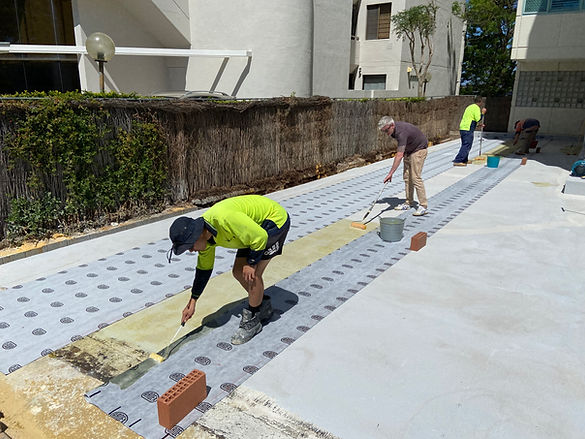




Conspar assists with the building maintenance needs of many Perth properties that are strata managed.
Working closely with strata managers and the companies they represent, Conspar stands out from the crowd in terms of offering the most cost-effective solutions to building problems without compromising on expertise and service delivery since it began operating in 1969.
Whether it be detecting a long-standing water ingress problem to treating the resultant concrete cancer or waterproofing balconies to preventative maintenance installation of protective coatings, Conspar can assist.
If more than one area of repairs is required, Conspar can also assist from roofwork, brickwork, plumbing and window work to carpentry, tiling and painting.
Helping to protect Perth’s heritage buildings
Address cracking of brickwork on building facade.
Address cracking of brickwork on building facade.
PROJECT TEAM
PROJECT TEAM
SERVICES OVERVIEW
PROJECT TEAM
Carry out concrete cancer treatment of structural concrete columns and leading edges of carport.
Address concrete cancer at carport underneath balcony.
Carry out concrete cancer treatment of structural concrete columns and leading edges of carport.
Address concrete cancer at carport underneath balcony.
Address concrete cancer at carport underneath balcony.





Led by two registered builders, Conspar provides building defect reports and is able to carry out the repairs for you.
All work is carried out to Australian Standards and based on 50 years' experience in the building industry.
Led by two registered builders, Conspar provides building defect reports and is able to carry out the repairs for you.
All work is carried out to Australian Standards and based on 50 years' experience in the building industry.
Led by two registered builders, Conspar provides building defect reports and is able to carry out the repairs for you.
All work is carried out to Australian Standards and based on 50 years' experience in the building industry.
Led by two registered builders, Conspar provides building defect reports and is able to carry out the repairs for you.
All work is carried out to Australian Standards and based on 50 years' experience in the building industry.
PROJECT TEAM
PROJECT TEAM
PHONE
OFFICE
Leaking Balconies & Terraces
CAUSES OF LEAKS THROUGH TERRACES AND BALCONIES AND HOW IT IS FIXED

Replacement of leaking waterproof membrane to a suspended concrete slab above a carpark using Ardex1000 sheet membrane with a 20 year materials warranty.
Is There a Waterproof Membrane?
In many properties, whether new or old, external tiled floor surfaces of balconies and terraces are usually the main source of moisture penetration. This causes leaks and property damage to areas below such as internal living spaces, basements or underground carparks. The cause of this water penetration is usually a lack of or failure of a waterproof membrane (WPM).
When there is a lack of or failure of a WPM between a tiled surface and concrete slab substrate, water is able to penetrate through the tiles and / or grout, come into direct contact with the concrete substrate, penetrate through the concrete to the structural steel and start the concrete cancer process.
What About the Fall?
If a balcony or terrace lacks sufficient fall, which would normally allow for water run-off, any excess water will pond on the floor surface and stay there for extended periods of time. This resting water increases the likelihood of it penetrating the floor surface and accessing the substrate below which can lead to concrete cancer.
Long-term Solutions
The first step to treating terrace or balcony leaks is to be able to understand the building you are dealing with, which can only be done by reviewing any drawings available.
The second step is to conduct a destructive inspection to determine;
-
the type and condition of the substrate
-
the thickness of the substrate
-
the condition / presence and type of any existing WPM
These factors are important in determining the type of new WPM required and the value of the works.
The only way to address the cause of the issues and provide a long-term solution, is to replace the existing WPM with a new, durable and flexible WPM system. This involves:
-
Removing floor and skirting tiles, and existing WPM to entire area.
-
Preparing existing structural concrete substrate.
-
Supplying / installing new screed substrate.
-
Applying new waterproof membrane over new screed substrate – lapping down into drains and lapping up at wall junctions.
-
Installing new floor tiles and skirting tiles to terrace area.
Maybe I'll Just Seal Over the Tiles...
Sealants simply applied to the surface of the tiled floor do not provide a mid-long term solution. These coatings are non-flexible and crack following movement in the tiled or concrete substrate due to the natural, daily and seasonal process of thermal expansion and contraction.
Can I Just Repair the Area That's Leaking?
The method of removing the tiles and surface finishes directly above the damaged area, repairing the substrate, and then replacing the WPM in the localised area does not provide a long term solution and certainly will not provide the owners with 10 or 20 year warranties for the work. There is also no way of knowing whether water will continue to leak through tiles in other areas and penetrate through these untreated areas allowing structural damage to develop. Eventually owners are reconciled to having to install a new WPM down the track once substantial damage has had time to build up.
